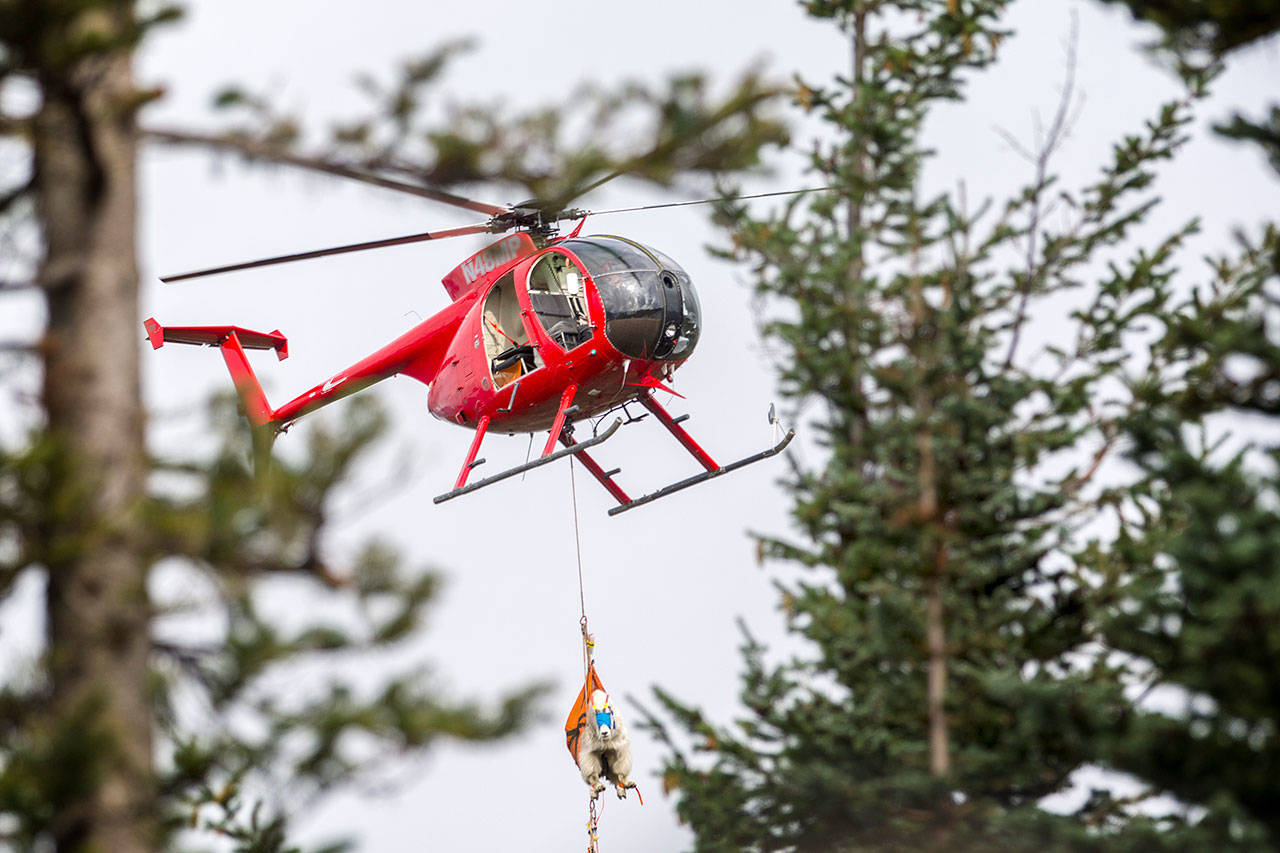OLYMPIC NATIONAL PARK — The first round of goat wrangling in Olympic National Park has come to an end and 98 goats have been moved to the North Cascades.
Monday marked the conclusion of the two-week capture and translocation process that moved 98 mountain goats from Olympic National Park to the North Cascades — including 11 kids that were released with their nannies — and removed 115 mountain goats from the park.
Six mountain goat orphans were transferred to Northwest Trek Wildlife Park. There were six adult deaths during capture.
Two goats died during transport on the first day.
Three goats were killed because they were “unfit for translocation,” according to a news release.
One adult male that Olympic National Park has monitored had “reports of very habituated behavior and some aggressive encounters with visitors,” said Penny Wagner, park spokesperson.
“As we said in the [Final Environmental Impact State], we would not translocate any aggressive goats.”
She said that billy was the only known aggressive goat in the population in 2018.
She said two kids showed symptoms of a disease called Orf and that veterinarians felt it was not a good idea to move them.
For two weeks, blindfolded mountain goats could be seen near Hurricane Ridge dangling from helicopters as crews worked to move them to the North Cascades. Veterinarians on-site made sure they were healthy enough for transport.
“The success of this year’s translocation effort is thanks to the cooperation and expertise of more than 175 people, including 77 volunteers from Washington Department of Fish and Wildlife,” said Patti Happe, park wildlife branch chief.
“The collaboration with our partner agencies and the support from everyone involved was phenomenal.”
Aerial capture operations were conducted through a contract with a private company, Leading Edge Aviation, which specializes in the capture of wild animals.
That contract was for a maximum of $189,479, with the final amount depending on how many hours were flown.
The helicopter crew used tranquilizer darts and net guns to capture mountain goats and transported them in specially made slings to the staging area on Hurricane Hill Road.
Due to weather, the helicopter crew was able to operate for only 10 of the 14 days, and several of those days ended early.
Operations will continue next year during two additional two-week periods. Capture and translocation may continue in 2020 depending on what happens next year.
The park estimates that there are about 725 mountain goats in the park. Officials anticipate being able to remove only half of them. The rest will be killed.
State Fish and Wildlife released mountain goats at five sites in the Cascades with the help of tribal and university biologists, and of Hi-Line Aviation of Darrington.
Two of the release areas were near mountain peaks south of the town of Darrington, on the Darrington District of the Mount Baker-Snoqualmie National Forest.
The others sites were located northwest of Kachess Lake (just south of the Alpine Lakes Wilderness) in the Okanogan-Wenatchee National Forest, Tower Peak in the Methow area of the Okanogan-Wenatchee National Forest, and the headwaters of the Cedar River Drainage, which is land owned by Seattle Public Utilities.
In May, the National Park Service released the final Mountain Goat Management Plan, which outlines the effort to remove the estimated 725 mountain goats on the Olympic Peninsula.
Both the plan and the associated environmental impact statement were finalized after an extensive public review process which began in 2014.
Tribes lending support to the translocation effort in the Cascades include the Lummi, Muckleshoot, Sauk-Suiattle, Stillaguamish, Suquamish, Swinomish, Tulalip and Upper Skagit tribes.
________
Reporter Jesse Major can be reached at 360-452-2345, ext. 56250, or at jmajor@peninsuladailynews.com.

